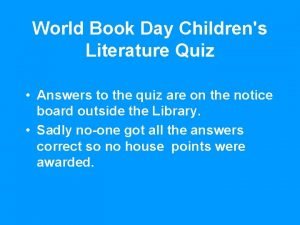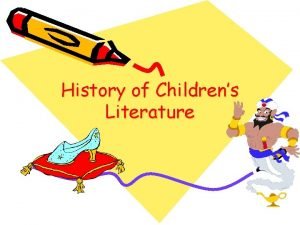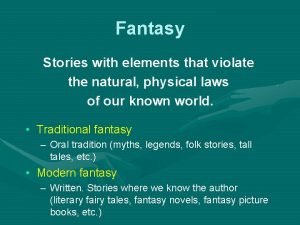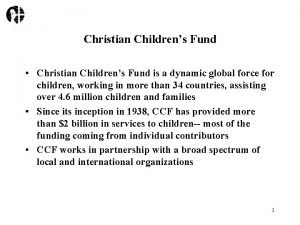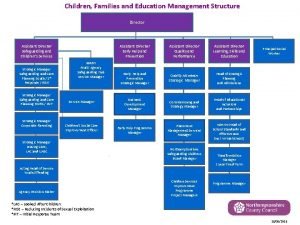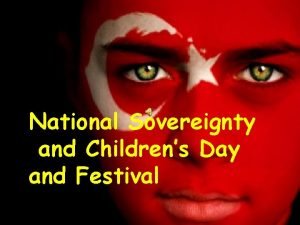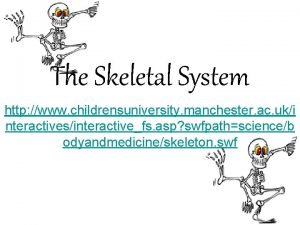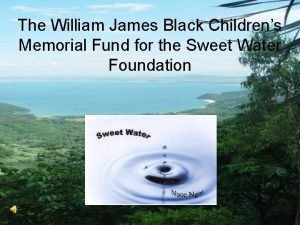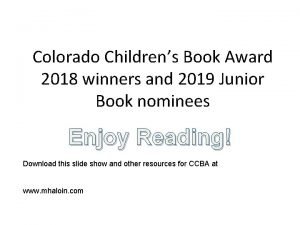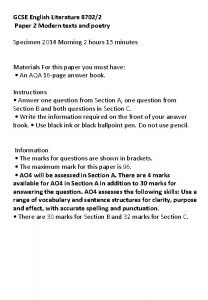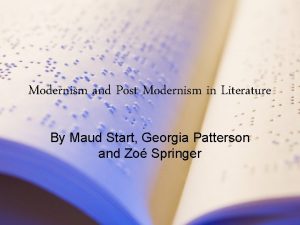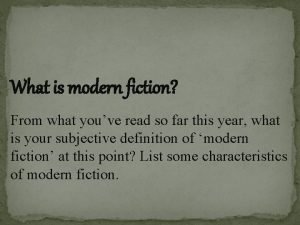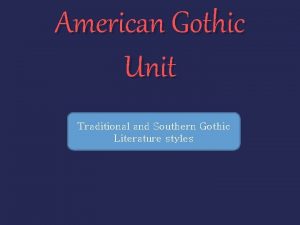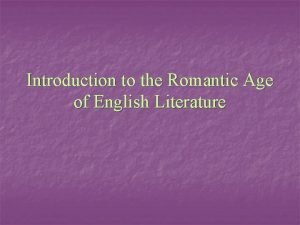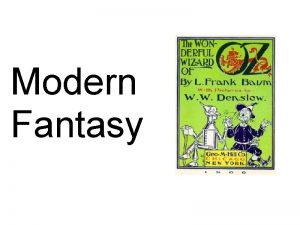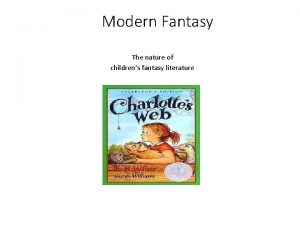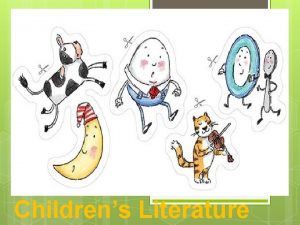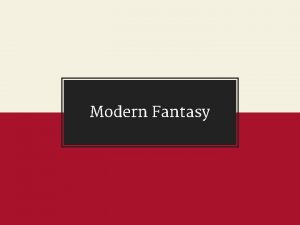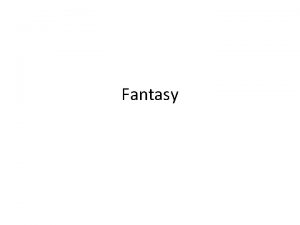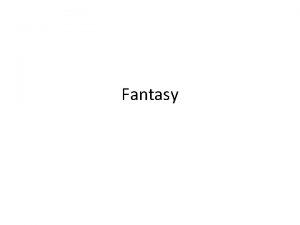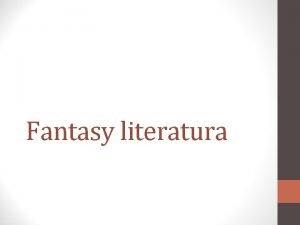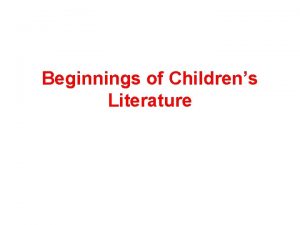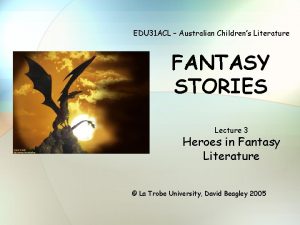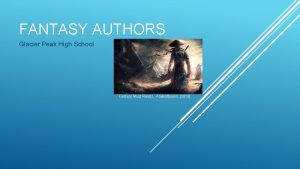Modern Fantasy The nature of childrens fantasy literature































- Slides: 31

Modern Fantasy The nature of children’s fantasy literature Some material from Zena Sutherland, Children and Books, 9 th ed. New York: Addison-Wesley, 1997.

“Make believe” l l A commonplace and, probably, essential part of childhood is playing “make believe. ” For that matter, we continue to make believe, to daydream or fantasize, for the rest of our lives.

Make believe and novels l Any novel or play is, by its very nature, an act of make believe: characters perform actions created by the imagination of the writer l The appeal of fiction and drama is inseparable from this matter of making believe

And so. . . l . . . it is hardly surprising that fantasy is particularly popular with children readers.

What is fantasy? l a work of literature that imaginatively breaks free from the limits and limitations of realism in explicit ways.

Definition l Sutherland says, “The special quality of fantasy is that it concerns things that cannot really happen or that it is about people or creatures who do not exist, yet within the framework of each story there is a selfcontained logic, a wholeness of conception that has its own reality. If it does not, it fails” (227).

“a self-contained logic” l The magic elements within a fantasy must be consistent and reasonable: l can’t have a prodigious mind-reader who gets baffled by another character’s thoughts at a crucial moment

“a self-contained logic” l The magic elements within a fantasy must be consistent and reasonable: l l can’t have a prodigious mind-reader who gets baffled by another character’s thoughts at a crucial moment—unless there’s a good explanation can’t have characters desperately fighting to avoid dying if we then see that death is positive and welcoming

Three characteristics l Sutherland adds that a good fantasy will contain these three characteristics (among others): sincerity (not too coy or overly whimsical), directness (addressing children as equals, or at least with respect, and not talking down to them), and imagination.

Popular form l What are some of your favorite fantasy books from childhood?

Why so popular? l 1. The display of the author’s imagination can be delightful, surprising, etc. It also can stimulate the reader’s imagination. Kids often have terrific imaginations, and being able to exercise it can be very satisfying: in real life, a kid is just a kid; but when she puts her imagination to work, she is a god!

Why so popular? l 2. The possibilities that are explored or illustrated in fantasies are delightful, exciting, desirable, etc.

Why so popular? l 3. Fantasies are often very liberating; because they are not tied down by the limits of reality, there can be fun, excitement, and experiences that make the readers feel released in some way. l A negative way of saying this might be that the books are escapist, a term that we often use disparagingly. But I think we can welcome this liberating power.

Why so popular? l 4. Fantasies take children far beyond the realm of ordinary experience, which can create events and scenes that are emotionally very powerful without being especially threatening; seeing a battle in a fantasy evokes an emotional response that is fairly safe; if we transferred the battle to everyday life, it could be very worrisome.

Why so popular? l 5. Fantasies allow children to do all sorts of things that they could never do in real life--all sorts of things that the readers could not do-and that’s fun.

Why so popular? l 6. Seeing kids do some of these things is very empowering to children: they see that kids can achieve great things. l The fact that kids (and adults) can’t achieve exactly what we see in the book--can’t go down the rabbit hole or talk to animals or fly to the incredible mushroom planet--is nowhere near as important as the fact that they have in fact achieved something great.

Low Fantasy and High Fantasy l Generally speaking, modern fantasies fall into one of two categories: low and high.

Low Fantasy and High Fantasy l All fantasies depend to some extent on “what Lloyd Alexander calls the ‘primary world’-people’s knowledge and experience of real life. .

Low Fantasy and High Fantasy l All fantasies depend to some extent on “what Lloyd Alexander calls the ‘primary world’-people’s knowledge and experience of real life. . Low fantasy is actually set in the primary world, but the magical elements of fantasy make the story impossible.

Low Fantasy and High Fantasy l All fantasies depend to some extent on “what Lloyd Alexander calls the ‘primary world’-people’s knowledge and experience of real life. . Low fantasy is actually set in the primary world, but the magical elements of fantasy make the story impossible. By contrast, writers of high fantasy take information and experiences from the primary world and project this information to create images and situations of a ‘secondary world. ’”

Low Fantasy and High Fantasy l l “Authors of high fantasy create a secondary world whose concrete elements are impossible according to the logic of the primary world but consistent with its own laws. “Some high fantasy stories remain totally in the created world, and some travel between that world and the primary world. Others involve a world within the primary world, marked by boundaries that keep the magic inside the created world. ” § (Children’s Books in Children’s Hands 351)

Kinds of Fantasies l l many folktales are traditional fantasies articulate animal tales--The Wind in the Willows, The Tale of Peter Rabbit, Charlotte’s Web, Poppy (by Avi) animated toys--Winnie the Pooh, The Indian in the Cupboard, The Castle in the Attic preposterous characters and situations--Pippi Longstocking, Mary Poppins, Tuck Everlasting, Harry Potter

Kinds of Fantasies l l l strange and curious worlds--Lewis Carroll; The Phantom Tollbooth, The Ear, the Eye, and the Arm, His Dark Materials, Charlie and the Chocolate Factory (inside the factory is what we can call a fantastic and curious world) little people--the Borrowers, all manner of fairy / pixie / brownie stories ghost / spirit stories--The Secret of Green Knowe

Kinds of Fantasies l l l time warps—King of Shadows science fiction--Madeleine l’Engle high fantasy--more mythic, usually, than most of the above; often involving quests and conflicts of enormous importance; usually involving active use of magic of some sort; Earthsea series, Prydain Chronicles, Sabriel series

3 key fantasy elements l l According to Sutherland, writers of fantasy usually manipulate one or more of the following three elements in creating a fantasy: setting, characters, and time. In each case, the story presents these in something other than familiar, “normal, ” realistic ways.

3 key fantasy elements l l The Oz books rely on a new and imaginative setting to a certain extent. They also use characters that are different from what we know in real life (the Highly Magnified Wobblebug, for example).

3 key fantasy elements l The Boggart and The Dark Is Rising on the one hand, and Charlotte’s Web on the other, present our world with the addition of special, fantastical characters.

3 key fantasy elements l l The Ear, the Eye, and the Arm moves forward in time a few hundred years, thereby manipulating time. It also includes the three title characters and the blue monkey as fantasy elements.

Six basic fantasy motifs l l Specific elements appear again and again in fantasies. These elements include such things as characters, settings, plot details, and so on. They are commonly referred to as motifs. In Stith Thompson’s Motif-index of Folk Literature (1932), he identifies hundreds of recurring motifs: “flight from the ball” is one.

Six basic fantasy motifs l More useful for everyday purposes is this list, from Linda Lee Madsen (1976): l l l magic other worlds--or secondary worlds good versus evil (not just good and bad) heroism and the hero’s quest special character types fantastic objects

 Traditional literature quiz
Traditional literature quiz History of childrens literature
History of childrens literature Modern fantasy elements
Modern fantasy elements Types of modern fantasy
Types of modern fantasy Moli texas children's hospital
Moli texas children's hospital Childrens christian fund
Childrens christian fund Childrens services
Childrens services Childrens services walsall
Childrens services walsall Levine childrens
Levine childrens 23 april international children's day turkey
23 april international children's day turkey Multi agency assessment
Multi agency assessment Childrens university of manchester
Childrens university of manchester Longman children's dictionary
Longman children's dictionary Black childrens memorial
Black childrens memorial Fever in toddlers when to worry
Fever in toddlers when to worry Colorado children's book award
Colorado children's book award Nature and nature's law lay hid in night
Nature and nature's law lay hid in night Determinace lidské psychiky
Determinace lidské psychiky English literature paper 2
English literature paper 2 The modern era literature
The modern era literature What is modern fiction in literature
What is modern fiction in literature Best american gothic novels
Best american gothic novels Modern literature definition
Modern literature definition Nature of drama
Nature of drama Definition of romantic age
Definition of romantic age Hát kết hợp bộ gõ cơ thể
Hát kết hợp bộ gõ cơ thể Slidetodoc
Slidetodoc Bổ thể
Bổ thể Tỉ lệ cơ thể trẻ em
Tỉ lệ cơ thể trẻ em Chó sói
Chó sói Chụp phim tư thế worms-breton
Chụp phim tư thế worms-breton Chúa yêu trần thế alleluia
Chúa yêu trần thế alleluia
